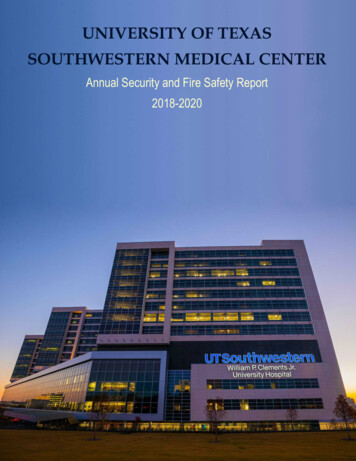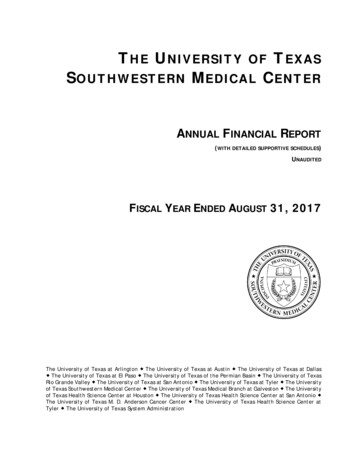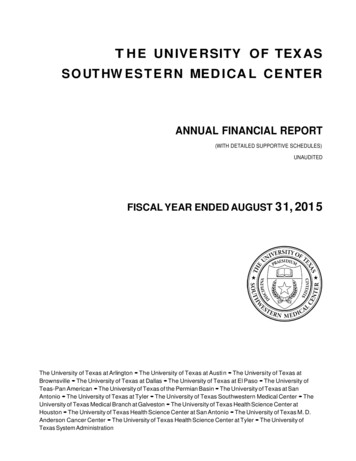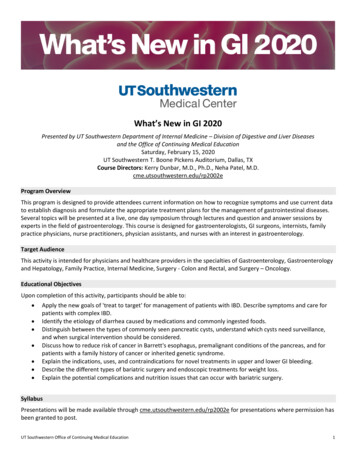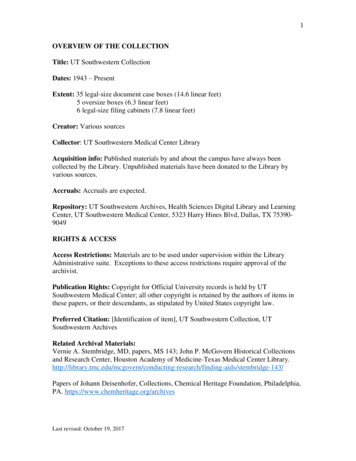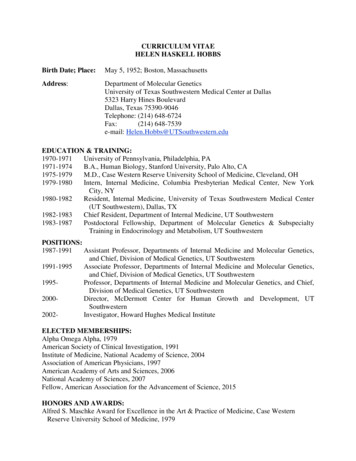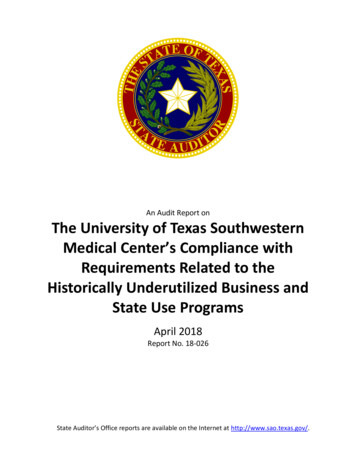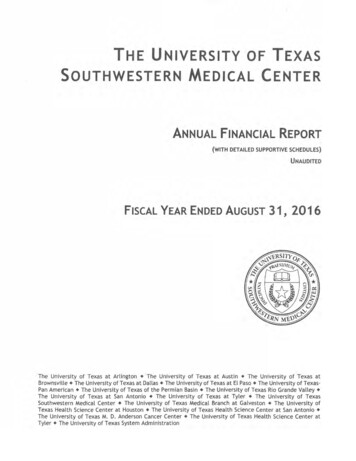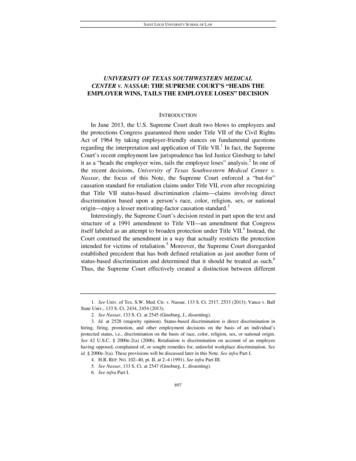
Transcription
SAINT LOUIS UNIVERSITY SCHOOL OF LAWUNIVERSITY OF TEXAS SOUTHWESTERN MEDICALCENTER V. NASSAR: THE SUPREME COURT’S “HEADS THEEMPLOYER WINS, TAILS THE EMPLOYEE LOSES” DECISIONINTRODUCTIONIn June 2013, the U.S. Supreme Court dealt two blows to employees andthe protections Congress guaranteed them under Title VII of the Civil RightsAct of 1964 by taking employer-friendly stances on fundamental questionsregarding the interpretation and application of Title VII.1 In fact, the SupremeCourt’s recent employment law jurisprudence has led Justice Ginsburg to labelit as a “heads the employer wins, tails the employee loses” analysis.2 In one ofthe recent decisions, University of Texas Southwestern Medical Center v.Nassar, the focus of this Note, the Supreme Court enforced a “but-for”causation standard for retaliation claims under Title VII, even after recognizingthat Title VII status-based discrimination claims—claims involving directdiscrimination based upon a person’s race, color, religion, sex, or nationalorigin—enjoy a lesser motivating-factor causation standard.3Interestingly, the Supreme Court’s decision rested in part upon the text andstructure of a 1991 amendment to Title VII—an amendment that Congressitself labeled as an attempt to broaden protection under Title VII.4 Instead, theCourt construed the amendment in a way that actually restricts the protectionintended for victims of retaliation.5 Moreover, the Supreme Court disregardedestablished precedent that has both defined retaliation as just another form ofstatus-based discrimination and determined that it should be treated as such.6Thus, the Supreme Court effectively created a distinction between different1. See Univ. of Tex. S.W. Med. Ctr. v. Nassar, 133 S. Ct. 2517, 2533 (2013); Vance v. BallState Univ., 133 S. Ct. 2434, 2454 (2013).2. See Nassar, 133 S. Ct. at 2545 (Ginsburg, J., dissenting).3. Id. at 2528 (majority opinion). Status-based discrimination is direct discrimination inhiring, firing, promotion, and other employment decisions on the basis of an individual’sprotected status, i.e., discrimination on the basis of race, color, religion, sex, or national origin.See 42 U.S.C. § 2000e-2(a) (2006). Retaliation is discrimination on account of an employeehaving opposed, complained of, or sought remedies for, unlawful workplace discrimination. Seeid. § 2000e-3(a). These provisions will be discussed later in this Note. See infra Part I.4. H.R. REP. NO. 102–40, pt. II, at 2–4 (1991). See infra Part III.5. See Nassar, 133 S. Ct. at 2547 (Ginsburg, J., dissenting).6. See infra Part I.897
SAINT LOUIS UNIVERSITY SCHOOL OF LAW898SAINT LOUIS UNIVERSITY LAW JOURNAL[Vol. 59:897types of discrimination and made it harder for employees to get relief forretaliatory efforts of their employers.The effects of this decision are immediate and catastrophic, especially fortrial courts left with the mess of trying to properly instruct juries in Title VIIcases in which the plaintiff alleges both status-based discrimination andretaliation (a common occurrence).7 Indeed, “[a]sking jurors to determineliability based on different standards in a single case is virtually certain to sowconfusion.”8 Moreover, because the decision weakens Title VII’s prohibitionagainst retaliation, employees will be less willing to confront discrimination inthe workplace for fear of the retaliatory efforts of their employers.9 Title VII’sprohibition against status-based discrimination depends in large part onemployees policing their employers, and, thus, without their participation, TitleVII’s overall scheme will suffer.10 In light of these important adverse effects,Congress must act. Indeed, as Justice Ginsburg noted in her dissent in Nassar,the Supreme Court’s “misguided judgment” in Nassar “should prompt yetanother Civil Rights Restoration Act.”11Part I of this Note will discuss the applicable sections of Title VII, as wellas Supreme Court decisions interpreting and broadening antiretaliationprovisions. Part II will analyze the Supreme Court’s decision in PriceWaterhouse v. Hopkins, the Court’s first major decision regarding causationstandards in mixed-motive cases under Title VII. Part III will then discuss theCivil Rights Act of 1991 and its amendments to Title VII, as well as lowercourts’ decisions regarding the applicability of Price Waterhouse and the 1991Act to Title VII retaliation claims. Part IV will then analyze Gross v. FBLFinancial Services, Inc., a key turning point in the Court’s jurisprudenceregarding causation standards. Part V will provide a detailed analysis ofUniversity of Texas Southwestern Medical Center v. Nassar, the SupremeCourt’s most recent decision regarding a motivating-factor standard in TitleVII retaliation claims. Part VI will provide a critique of the Court’s decision inNassar. Finally, Part VII will propose that Congress amend Title VII in light ofthe Court’s decision.7. See Nassar, 133 S. Ct. at 2546 (Ginsburg, J., dissenting).8. Id.9. See infra Part VI.C.10. See infra Part VI.C.11. Nassar, 133 S. Ct. at 2547 (Ginsburg, J., dissenting). Justice Ginsburg’s suggestion of a“Civil Rights Restoration Act” refers to the 1991 Civil Rights Act, a set of amendments to TitleVII, and other statutes Congress enacted in response to Supreme Court decisions which reducedthe protections afforded to individuals under those statutes. See also infra Part III.
SAINT LOUIS UNIVERSITY SCHOOL OF LAW2015]UNIVERSITY OF TEXAS SOUTHWESTERN MEDICAL CENTER V. NASSAR899I. TITLE VII OF THE CIVIL RIGHTS ACT OF 1964Title VII of the Civil Rights Act of 1964 (Title VII) makes it “an unlawfulemployment practice for an employer . . . to discriminate against anyindividual . . . because of such individual’s race, color, religion, sex, ornational origin.”12 This provision prohibits “status-based discrimination,” thefirst of two categories of wrongful employer conduct condemned by TitleVII.13 The second category of wrongful employer conduct prohibited by TitleVII is employer retaliation against an employee who complains ofdiscrimination in the workplace.14 Title VII’s prohibition against retaliationprovides that an employer commits an unlawful employment practice when it“discriminate[s] against any individual . . . because he has opposed anypractice made an unlawful employment practice by this subchapter, or becausehe has made a charge, testified, assisted, or participated in any manner in aninvestigation, proceeding, or hearing under this subchapter.”15 Thus, whilestatus-based discrimination is direct discrimination based on an individual’sprotected status, retaliation is discrimination for complaining about statusbased discrimination.16Prohibitions against retaliation are necessary to reinforce prohibitionsagainst status-based discrimination;17 indeed, “[t]he realities of retaliation in12. 42 U.S.C. §§ 2000e-2(a)(1)–(2) (2006). The full language of the provision is as follows:It shall be an unlawful employment practice for an employer—(1) to fail or refuse to hireor to discharge any individual, or otherwise to discriminate against any individual withrespect to his compensation, terms, conditions, or privileges of employment, because ofsuch individual’s race, color, religion, sex, or national origin; or (2) to limit, segregate, orclassify his employees or applicants for employment in any way which would deprive ortend to deprive any individual of employment opportunities or otherwise adversely affecthis status as an employee, because of such individual’s race, color, religion, sex, ornational origin.Id.13. See Nassar, 133 S. Ct. at 2522.14. Id.15. 42 U.S.C. § 2000e-3(a). The exact language of this provision is as follows:It shall be an unlawful employment practice for an employer to discriminate against anyof his employees or applicants for employment, for an employment agency, or joint labormanagement committee controlling apprenticeship or other training or retraining,including on-the-job training programs, to discriminate against any individual, or for alabor organization to discriminate against any member thereof or applicant formembership, because he has opposed any practice made an unlawful employment practiceby this subchapter, or because he has made a charge, testified, assisted, or participated inany manner in an investigation, proceeding, or hearing under this subchapter.Id.16. Compare 42 U.S.C. §§ 2000e-2(a)(1)–(2), with 42 U.S.C. § 2000e-3(a).17. Individuals find it difficult to acknowledge that they have been discriminated against;once they overcome that hurdle and recognize the discrimination, they then struggle with
SAINT LOUIS UNIVERSITY SCHOOL OF LAW900SAINT LOUIS UNIVERSITY LAW JOURNAL[Vol. 59:897response to claiming discrimination necessitate strong legal protection fromretaliation if the law is to provide meaningful nondiscrimination guarantees.”18Even the Supreme Court has noted the importance of antiretaliation provisions:Title VII depends for its enforcement upon the cooperation of employees whoare willing to file complaints and act as witnesses. “Plainly, effectiveenforcement could thus only be expected if employees felt free to approachofficials with their grievances.” Interpreting the antiretaliation provision toprovide broad protection from retaliation helps ensure the cooperation upon19which accomplishment of the Act’s primary objective depends.Many Supreme Court decisions have in fact demonstrated the SupremeCourt’s willingness to interpret Title VII’s prohibition against retaliation in away that strengthens the prohibition against status-based discrimination.20 Forexample, in Burlington Northern and Santa Fe Railway Co. v. White, theSupreme Court held that the “scope of the antiretaliation provision extendsbeyond workplace-related or employment-related retaliatory acts and harm.”21In that case, after the employee complained about workplace discrimination,the employer changed the employee’s job responsibilities and suspended herchallenging the discrimination. One commentator has described the reluctance many individualsface in first recognizing that they have been discriminated against:As anyone who has experienced bias or prejudice knows, naming and challengingdiscrimination is socially and psychologically difficult. By the time retaliation intervenesto punish someone for alleging discrimination, that person has already overcome a myriadof psychological and social forces operating to suppress that claim. Research in socialpsychology has documented a marked reluctance among the targets of discrimination tolabel and confront their experiences as such . . . . Retaliation performs important work ininstitutions. One of the most palpable functions of retaliation is to suppress challenges toperceived inequality. Retaliation performs much of this work without ever actually beinginflicted on the potential challenger. Decisions about whether to challenge discriminationrest on a careful balancing of the costs and benefits of doing so.Deborah L. Brake, Retaliation, 90 MINN. L. REV. 18, 25–26, 36 (2005). The fear of retaliationwill be discussed in relation to Title VII’s antiretaliation statute later in this Note. See infra PartVI.18. Brake, supra note 17, at 42.19. Burlington N. & Santa Fe Ry. v. White, 548 U.S. 53, 67 (2006) (citations omitted). TheCourt further clarified:The antiretaliation provision seeks to secure that primary objective by preventing anemployer from interfering (through retaliation) with an employee’s efforts to secure oradvance enforcement of the Act’s basic guarantees. The substantive provision seeks toprevent injury to individuals based on who they are, i.e., their status. The antiretaliationprovision seeks to prevent harm to individuals based on what they do, i.e., their conduct.Id. at 63.20. For a more in-depth analysis of the Supreme Court’s pro-plaintiff retaliation decisions,see Deborah L. Brake, Retaliation in an EEO World, 89 IND. L.J. 115 (2014).21. Burlington, 548 U.S. at 67.
SAINT LOUIS UNIVERSITY SCHOOL OF LAW2015]UNIVERSITY OF TEXAS SOUTHWESTERN MEDICAL CENTER V. NASSAR901for multiple weeks without pay.22 Some courts had required employees todemonstrate a materially adverse change in the terms and conditions ofemployment to succeed on a retaliation claim, but the Supreme Courtdetermined that any materially adverse employment action could constituteretaliation as long as the action would dissuade a reasonable worker fromcomplaining about the discrimination.23 Moreover, in Thompson v. NorthAmerican Stainless, L.P., the Supreme Court held that a third party who nevercomplained of status-based discrimination but is the subject of retaliation aftera different individual complained of status-based discrimination can maintain aretaliation claim under Title VII.24Furthermore, not only has the Supreme Court broadened the scope of TitleVII’s antiretaliation provisions, it has also shown a willingness to viewretaliation as just another form of discrimination in other contexts beyond TitleVII.25 Indeed, even when statutes do not explicitly proscribe retaliation but doproscribe status-based discrimination, the Supreme Court has determined thatthe status-based discrimination prohibition within the statute implicitlycontains a prohibition against retaliation.26 In doing so, the Court has statedthat “[r]etaliation against a person because [he] has complained of . . .discrimination is another form of intentional . . . discrimination.”27 Thus, inJackson v. Birmingham Board of Education, the Court determined that anindividual could bring a retaliation claim under Title IX, even though thestatute only explicitly prohibited sex discrimination.28 Moreover, in Sullivan v.Little Hunting Park, Inc., the Court held that a plaintiff could bring aretaliation claim under 42 U.S.C. § 1982, which provides that “[a]ll citizens . . .shall have the same right . . . as is enjoyed by white citizens . . . to inherit,purchase, lease, sell, hold, and convey real and personal property.”29 InGómez-Pérez v. Potter, the Court held the federal-sector provision of the AgeDiscrimination in Employment Act (ADEA), which provides that “[a]llpersonnel actions affecting employees or applicants for employment who are at22. Id. at 58–59.23. Id. at 60, 68.24. Thompson v. N. Am. Stainless, L.P., 131 S. Ct. 863, 868–70 (2011).25. This jurisprudence was a key argument in Justice Ginsburg’s dissent in Nassar. See infraPart V. Indeed, when speculating about the outcome in Nassar, one commentator noted that thedecision would boil down to whether or not a majority of the justices would follow the line ofdecisions that label retaliation as another form of discrimination. See Kevin Russell, ArgumentPreview: Proving Retaliation Under Title VII, SCOTUSBLOG (Apr. 23, 2013, 5:06 view-proving-retaliation-under-title-vii/.26. See Jackson v. Birmingham Bd. of Educ., 544 U.S. 167, 173 (2005).27. Id.28. Id. at 173–74.29. Sullivan v. Little Hunting Park, Inc., 396 U.S. 229, 235 n.3, 237 (1969). Thus, a whitetenant could sue under the statute for retaliation he suffered after complaining aboutdiscrimination towards his black tenant. Id. at 237.
SAINT LOUIS UNIVERSITY SCHOOL OF LAW902SAINT LOUIS UNIVERSITY LAW JOURNAL[Vol. 59:897least 40 years of age . . . shall be made free from any discrimination based onage,” also prohibited retaliation.30 And, in CBOCS West, Inc. v. Humphries, theCourt determined that 42 U.S.C. § 1981, which provides that “[a]ll personswithin the jurisdiction of the United States shall have the same right in everyState and Territory to make and enforce contracts . . . as is enjoyed by whitecitizens,” encompassed retaliation claims.31Given the relatedness of Title VII’s antidiscrimination and antiretaliationprovisions, the extent to which the broad interpretation of retaliationstrengthens the provision against status-based discrimination, and the historyof Supreme Court decisions defining retaliation as another form ofdiscrimination, one can easily understand Justice Ginsburg’s observation that“the ban on discrimination and the ban on retaliation against a discriminationcomplainant have traveled together.”32II. DEVELOPMENT OF CAUSATION STANDARD UNDER TITLE VII: PRICEWATERHOUSE V. HOPKINSOne continual point of contention under this framework has been thecorrect standard of causation a plaintiff must demonstrate in order to proveeither status-based discrimination or retaliation when the employer considersboth legitimate and illegitimate, i.e., discriminatory, reasons in making anemployment decision.33 Fundamental to understanding the history andcomplexity of the causation standard in these so-called “mixed-motive” casesis the Supreme Court’s decision in Price Waterhouse v. Hopkins.34 Indeed,Price Waterhouse may be “[o]ne of the most important cases in Title VIIhistory.”35 No analysis of the Court’s decision in Nassar would be completewithout fully examining the Court’s reasoning in Price Waterhouse.30. Gómez-Pérez v. Potter, 553 U.S. 474, 479 (2008) (quoting 29 U.S.C. § 633a(a) (2006))(internal quotation marks omitted).31. CBOCS W., Inc. v. Humphries, 553 U.S. 442, 445 (2008) (quoting 42 U.S.C. § 1981(a)(2006)) (internal quotation marks omitted).32. Univ. of Tex. S.W. Med. Ctr. v. Nassar, 133 S. Ct. 2517, 2535 (2013) (Ginsburg, J.,dissenting).33. This Note will deal exclusively with the causation standards under these “mixed-motive”cases as opposed to pretext cases. A mixed-motive claim involves a situation where the employerhas in fact considered both illegitimate and legitimate reasons for making its employmentdecision. A pretext claim, where the employer has not taken both illegitimate and legitimatefactors into consideration, is governed by the McDonnell Douglas burden-shifting framework.See McDonnell Douglas v. Green, 411 U.S. 792, 802 (1973).34. Price Waterhouse v. Hopkins, 490 U.S. 228 (1989).35. Lawrence D. Rosenthal, A Lack of “Motivation,” or Sound Legal Reasoning? Why MostCourts Are Not Applying Either Price Waterhouse’s or the 1991 Civil Rights Act’s MotivatingFactor Analysis to Title VII Retaliation Claims in a Post-Gross World (But Should), 64 ALA. L.REV. 1067, 1075 (2013). “Not only did this case address burden shifting, gender stereotyping,
SAINT LOUIS UNIVERSITY SCHOOL OF LAW2015]UNIVERSITY OF TEXAS SOUTHWESTERN MEDICAL CENTER V. NASSAR903In Price, a female employee at an accounting firm sued her employer forsex discrimination when the firm refused to admit her as a partner.36 Whilethere were “clear signs” that partners at the firm “reacted negatively to [theemployee’s] personality because she was a woman,”37 the employer alsointroduced evidence of her lack of interpersonal skills.38 The trial judgeconcluded that even though the employer legitimately considered her lack ofinterpersonal skills in its decision to deny her partner status, the trial judge heldthat “[the employer] had unlawfully discriminated against [her] on the basis ofsex by consciously giving credence and effect to partners’ comments thatresulted from sex stereotyping.”39 Moreover, the judge found that because theemployer had not demonstrated that it would have denied her partner statusregardless of the discrimination, the employer could not avoid equitablerelief.40On appeal, the Court of Appeals for the D.C. Circuit affirmed the districtcourt’s conclusion but determined that an employer could outright avoid TitleVII liability if it proved “by clear and convincing evidence, that it would havemade the same decision in the absence of discrimination.”41The Supreme Court, recognizing a split among the circuits, grantedcertiorari in the case to decide, in part, the proper standard of causation whenan employer’s adverse employment decision resulted from a mixture oflegitimate and illegitimate motives.42 Doing so required the Court to interpretthe meaning of the words “because of” in Title VII’s provision againstdirect evidence, and the meaning of ‘because of,’ it was also one of several cases that led toCongress’s passing of the 1991 Act.” Id. (citations omitted).36. Price Waterhouse, 490 U.S. at 231–32.37. Id. at 235 (“One partner described her as ‘macho’; another suggested that she‘overcompensated for being a woman’; a third advised her to take ‘a course at charm school’.Several partners criticized her use of profanity; in response, one partner suggested that thosepartners objected to her swearing only ‘because it’s a lady using foul language.’ . . . [I]n order toimprove her chances for partnership, [one male partner] advised, [the female employee] should‘walk more femininely, talk more femininely, dress more femininely, wear make-up, have herhair styled, and wear jewelry.’” (citations omitted)).38. Id. at 236.39. Id. at 237.40. Id.41. Price Waterhouse, 490 U.S. at 237. Thus, while the district court found that an employercould avoid only equitable relief by demonstrating by clear and convincing evidence that it wouldhave taken the same employment decision regardless of the discrimination, the D.C. Circuitdetermined that the employer could avoid liability by making that same showing. Id.42. Id. at 232. The Supreme Court described the split in the lower courts that preceded itsdecision in Price Waterhouse. See id. at 238 n.2. For a more in-depth discussion of the Title VIIcausation standards before the Supreme Court decided Price Waterhouse, see Mark S. Brodin,The Standard of Causation in the Mixed-Motive Title VII Action: A Social Policy Perspective, 82COLUM. L. REV. 292 (1982).
SAINT LOUIS UNIVERSITY SCHOOL OF LAW904SAINT LOUIS UNIVERSITY LAW JOURNAL[Vol. 59:897discrimination.43 Although there was no majority opinion, six of the Justicesdid agree that an employer acts “because of” a protected status when that statusis at least a motivating or substantial factor in taking an adverse employmentaction.44Justice Brennan, writing for a plurality of the justices, began his analysisby laying out the exact language of the statute and stated: “We take thesewords to mean that gender must be irrelevant to employment decisions. Toconstrue the words ‘because of’ as colloquial shorthand for ‘but-forcausation,’ . . . is to misunderstand them.”45 Moreover, Justice Brennandecisively determined that “because of” did not mean “solely because of,”citing Congress’s rejection of an amendment that would have placed the word“solely” before the words “because of” in the statute.46 This was demonstrativeevidence in his eyes that Congress intended to eliminate employment decisionsin which an illegitimate, discriminatory motive plays a part in an employmentdecision, even if it is not the sole reason for the decision.47 Thus, he concludedthat “[w]hen . . . an employer considers both gender and legitimate factors atthe time of making a decision, that decision was ‘because of’ sex.”48The Court did not end the analysis there, however. The Court went on toestablish a burden-shifting framework, opening up the door for employers toclaim an affirmative defense even if an employee could show that adiscriminatory motive played a part in the employer’s decision.49 Thus, if theemployee demonstrated that the prohibited trait was a motivating factor in theemployment decision, the burden then shifted to the employer to demonstratethat it would have taken the same employment action in the absence of the43. Price Waterhouse, 490 U.S. at 240. For the full language of the statute, see supra note12.44. Price Waterhouse, 490 U.S. at 248 (plurality opinion); id. at 259 (White, J., concurring);id. at 276 (O’Connor, J., concurring).45. Price Waterhouse, 490 U.S. at 240 (plurality opinion).46. Id. at 241 n.7.47. Id. at 241. In response to the dissent’s criticism of Brennan’s construction of the words“because of,” he stated:We need not leave our common sense at the doorstep when we interpret a statute. It isdifficult for us to imagine that, in the simple words ‘because of,’ Congress meant toobligate a plaintiff to identify the precise causal role played by legitimate and illegitimatemotivations in the employment decision she challenges. We conclude, instead, thatCongress meant to obligate her to prove that the employer relied upon sex-basedconsiderations in coming to its decision.Id. at 241–42.48. Id. at 241.49. Id. at 242.
SAINT LOUIS UNIVERSITY SCHOOL OF LAW2015]UNIVERSITY OF TEXAS SOUTHWESTERN MEDICAL CENTER V. NASSAR905discrimination.50 If the employer could make this showing, it would escapeliability.51The Supreme Court’s decision in Price Waterhouse, at least at first glance,did grant some protection to employees by allowing them to only demonstratethat their protected status was a motivating factor in the employer’s decision.52However, Price Waterhouse also allowed the employer to escape all liability ifit could demonstrate that it would have made the same decision regardless ofthe discriminatory motive.53 In the eyes of Congress, such a decision undulyrestricted the protections guaranteed under Title VII.54III. CONGRESS REACTS: CIVIL RIGHTS ACT OF 1991 BUT PRICE WATERHOUSESURVIVESA.Congress Extends Protection under the Civil Rights Act of 1991In response to Price Waterhouse and a number of other Supreme Courtdecisions “that sharply cut back on the scope and effectiveness” ofantidiscrimination laws,55 Congress enacted the Civil Rights Act of 1991 (the1991 Act).56 Indeed, the purpose of the 1991 Act was to provide “additionalprotections against unlawful discrimination in employment.”57 The 1991 Actcodified part of the framework of Price Waterhouse and discarded the rest.58Specifically, the legislation added a new subsection, § 2000e-2(m), to the50. Price Waterhouse, 490 U.S. at 258 (White, J., concurring).51. Id. Justice Brennan stated the new standard as follows:We hold that when a plaintiff in a Title VII case proves that her gender played amotivating part in an employment decision, the defendant may avoid a finding of liabilityonly by proving by a preponderance of the evidence that it would have made the samedecision even if it had not taken the plaintiff’s gender into account.Id.52. Id.53. Id.54. H.R. REP. NO. 102-40, pt. 2, at 2–4 (1991).55. Id. Some of the other decisions overruled by the 1991 Act included Patterson v. McLeanCredit Union, 491 U.S. 164, 177 (1989) (holding that 42 U.S.C. Section 1981 guaranteeing allpersons “the same right . . . to make and enforce contracts . . . as is enjoyed by white citizens”does not prohibit racial harassment on the job and other forms of race discrimination occurringafter the formation of a contract), and Library of Congress v. Shaw, 478 U.S. 310, 319 (1986)(holding that a party prevailing in a Title VII suit against the Government was not entitled tointerest on attorney’s fees because the provision permitting attorney’s fees did not expresslywaive sovereign immunity). See id.56. See Civil Rights Act of 1991, Pub. L. No. 102–166, 105 Stat. 1071. For a more in-depthdiscussion on the Civil Rights Act of 1991, see Michael D. Moberly & Linda H. Miles, TheImpact of The Civil Rights Act of 1991 on Individual Title VII Liability, 18 OKLA. CITY. U. L.REV. 475 (1993).57. § 2, 105 Stat. at 1071.58. See 42 U.S.C. §§ 2000e-2(m), -5(g)(2).
SAINT LOUIS UNIVERSITY SCHOOL OF LAW906SAINT LOUIS UNIVERSITY LAW JOURNAL[Vol. 59:897section governing status-based discrimination.59 The new provision stated:“[A]n unlawful employment practice is established when the complainingparty demonstrates that race, color, religion, sex, or national origin was amotivating factor for any employment practice, even though other factors alsomotivated the practice.”60 Therefore, the employee need only demonstrate thatthe prohibited status was a motivating factor in the employment decision.61Although the amendment saved the motivating-factor standard, thelegislation removed the ability of the employer to escape liability bydemonstrating that it would have made the employment decision regardless ofany discriminatory animus.62 Instead, Congress enacted § 2000e-5(g)(2), whichprovides:On a claim in which an individual proves a violation under section 2000e–2(m)of this title and [the employer] demonstrates that [it] would have taken thesame action in the absence of the impermissible motivating factor, thecourt . . . may grant declaratory relief, injunctive relief . . . and [limited]attorney’s fees and costs . . . and . . . shall not award damages or issue an order63requiring any admission, reinstatement, hiring, promotion, or payment.Thus, under both Price Waterhouse and the 1991 Act’s amendments, anemployee claiming discrimination under Title VII must only demonstrate thatthe employee’s protected status was a motivating factor in the employer’sadverse employment decision.64 However, while an employer could avoidliability by demonstrating that it would have made the same decisionregardless of the discrimination under Price Waterhouse, the 1991 Act’samendments provided that an employer’s demonstration that it would havemade the same decision absent a discriminatory motive would only lessendamages.65Key to the Supreme Court’s ultimate decision in Nassar was Congress’sdecision to codify, at least in part, the decision in Price Waterhouse by addingthe motivating-factor standards to the subsection of Title VII governing statusbased discrimination claims and not in a subsection governing Title VIIretaliation claims or a neutral Title VII subsection governing both types ofTitle VII claims.59.60.61.62.63.64.65.Id. § 2000e-2(m). The prohibition against retaliation is in id. § 2000e-3.Id. § 2000e-2(m).See id.See id. § 2000e-5(g)(2).42 U.S.C. § 2000e-5(g)(2).Price Waterhouse v. Hopkins, 490 U.S. 228, 241–42 (1989); 42 U.S.C. § 2000e-2(m).Compare Price Waterhouse, 490 U.S. at 242, with 42 U.S.C. § 2000e-5(g)(2).
SAINT LOUIS UNIVERSITY SCHOOL OF LAW2015]B.UNIVERSITY OF TEXAS SOUTHWESTERN MEDICAL CENTER V. NASSAR907Causation Standard for Retaliation Claims: Price Waterhouse or the 1991Act?After Congress
2015] UNIVERSITY OF TEXAS SOUTHWESTERN MEDICAL CENTER V. NASSAR 899 I. TITLE VII OF THE CIVIL RIGHTS ACT OF 1964 Title VII of the Civil Rights Act of 1964 (Title VII) makes it "an unlawful employment practice for an employer . . . to discriminate against any individual . . . because of such individual's race, color, religion, sex, or
